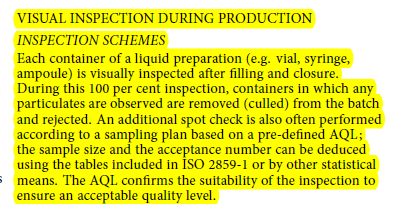1、欧洲药典5.17.2 Recommentdattions on testing of particulate contamination:visible particles

2、EU GMP Annex 1 Manufacture of Sterile Medicinal Products
附录1 无菌药品生产
EU | 2022-08-22
https://lib.shilinx.com:443/u/xm4wcq
8.30 All filled containers of parenteral products should be inspected individually for extraneous contamination or other defects. Defect classification and criticality should be determined during qualification and based on risk and historical knowledge. Factors to consider include, but are not limited to, the potential impact of the defect to the patient and the route of administration. Different defect types should be categorized and batch performance analysed. Batches with unusual levels of defects, when compared with routine defect numbers for the process (based on routine and trend data), should be investigated. A defect library should be generated and maintained which captures all known classes of defects. The defect library should be used for the training of production and quality assurance personnel. Critical defects should not be identified during any subsequent sampling and inspection of acceptable containers. Any critical defect identified subsequently should trigger an investigation as it indicates a possible failure of the original inspection process.
欧盟GMP Annex 1 征求意见稿 - 2017/12/20
Finishing of sterile products
8.18 Containers should be closed by appropriately validated methods. Containers closed by fusion, e.g. Form-Fill-Seal Small Volume Parenteral (SVP) & Large Volume Parenteral (LVP) bags, glass or plastic ampoules, should be subject to 100% integrity testing. Samples of other containers should be checked for integrity utilising validated methods and in accordance with QRM, the frequency of testing should be based on the knowledge and experience of the container and closure systems being used. A statistically valid sampling plan should be utilized. It should be noted that visual inspection alone is not considered as an acceptable integrity test method.
8.27 When inspection is done manually, it should be done under suitable and controlled conditions of illumination and background. Inspection rates should be appropriately validated. Operators performing the inspection should undergo robust visual inspection qualification (whilst wearing corrective lenses, if these are normally worn) at least annually. The qualification should be undertaken using appropriate sample sets and taking into consideration worst case scenarios (e.g. inspection time, line speed (where the product is transferred to the operator by a conveyor system), component size or fatigue at the end of shift) and should include consideration of eyesight checks. Operator distractions should be removed and frequent breaks of appropriate duration from inspection should be taken.
这{{threadTextType}}正{{isAdminText}}
为帮助审核人员更快处理,请填写举报原因:
为帮助审核人员更快处理,请填写举报原因:
